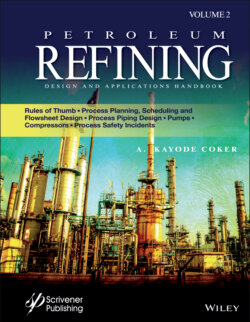Читать книгу Petroleum Refining Design and Applications Handbook - A. Kayode Coker - Страница 32
PARTICLE SIZE ENLARGEMENT
Оглавление1 1. The chief methods of particle size enlargement are compression into a mold, extrusion through a die followed by cutting or breaking to size, globulation of molten material followed by solidification, agglomeration under tumbling or otherwise agitated conditions with or without binding agents.
2 2. Rotating drum granulators have length-to-diameter ratios of 2–3, speeds 10–20 rpm, pitch as much as 10°. Size is controlled by speed, residence time, and amount of binder; 2–5 mm diameter is common.
3 3. Rotary disk granulators produce a more nearly uniform product than drum granulators: fertilizer, 1.5–3.5 mm diameter; iron ore 10–25 mm diameter.
4 4. Roll compacting and briquetting is done with rolls ranging from 130 mm diameter by 50 mm wide to 910 mm diameter by 550 mm wide. Extrudates are made 1–10 mm thick and are broken down to size for any needed processing, such as feed to tableting machines or to dryers.
5 5. Tablets are made in rotary compression machines that convert powders and granules into uniform sizes. The usual maximum diameter is about 38.1 mm (1.5 in.), but special sizes up to 101.6 mm (4 in.) diameter are possible. Machines operate at 100 rpm or so and make up to 10,000 tablets/min.
6 6. Extruders make pellets by forcing powders, pastes, and melts through a die followed by cutting. A 203.2-mm (8-in.) screw has a capacity of 907.2 kg/h (2000 lb/h) of molten plastic and is able to extrude tubing at 0.76–1.52 m/s (150–300 ft/min) and to cut it into sizes as small as washers at 8000/min. Ring pellet extrusion mills have hole diameters of 1.6–32 mm. Production rates are in the range of 30–200 lb/h-hp.
7 7. Prilling towers convert molten materials into droplets and allow them to solidify in contact with an air stream. Towers as high as 60 m (196.9 ft) are used. Economically the process becomes competitive with other granulation processes when a capacity of 200–400 tons/day is reached. Ammonium nitrate prills, for example, are 1.6–3.5 mm diameter in the 5–95% range.
8 8. Fluidized bed granulation is conducted in shallow beds 304.8–609.6 mm (12–24 in.) deep at air velocities of 0.1–2.5 m/s or 3–10 times the minimum fluidizing velocity, with evaporation rates of 0.005–1.0 kg/m2s. One product has a size range 0.7–2.4 mm diameter.
